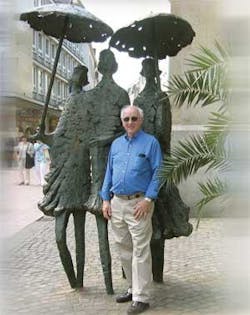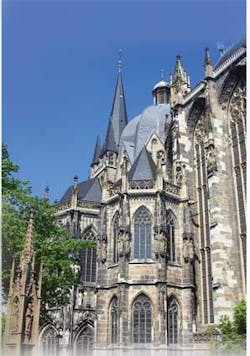Aachen hosts laser technology congress
David A. Belforte
Now offered with English translation, the biennial AKL conference provides insight into current laser materials processing activities
Aachen, the westernmost German city of 250,000 people, is located on the borders of Belgium and the Netherlands. In 1165 AD, as Aix la Chapelle, it was the former residence of Charlemagne, and the current Rathaus (city hall) was built over the ruins of his palace. This now revitalized, booming, and lively city is a fine place to visit. I’ve been here many times; the first time back in the 1990s to visit the famed Fraunhofer Institute for Production Technology (IPT), which was my introduction to this institute and its then unique industry/academic relationships. I was also pleased to later attend the opening of the Fraunhofer Institute for Laser Technology (ILT), one of the world’s premier laboratories for the advancement of lasers in manufacturing technology.
I’m here participating in the AKL ’08 International Laser Technology Congress (May 7–9), the latest in a series of biennial conferences organized and sponsored by Fraunhofer ILT. Prior to this year these conferences were conducted only in German so ILS did not attend. Now with simultaneous translation and the inclusion of papers in English, we have an opportunity to learn more about ILT-related research and development activities.
A speaking commitment at AKL has brought me to Aachen during what has to be one of the most beautiful weather weeks in a city that is notable as one of the rainiest in Germany–hence my pose in front of the famed sculpture Schirmträgerinnen (Ladies With Umbrellas; see Fig.1). I was told years ago about the rain records and that this sculpture was the artist’s wry take on this weather phenomenon. I now stand corrected because the Mayor of Aachen, a dynamic woman who is a tireless promoter of the city, informed me and my fellow conference goers that this statue is a reminder that Aachen was the umbrella capital of Germany (if not of all of Europe) and as such a key employer of the local citizenry. In fact, the umbrella factory, now the Ludwig Forum for International Art, was the venue for an enjoyable evening AKL reception.
Aachen is a university city, both historically and currently. It is famed as the home of the University of Aachen and now the RWTH Aachen. So the streets are alive with young students who bring vitality to what had otherwise been a socially dull city. The many sidewalk cafes are thronged by students and now by tourists who enjoy the Dom (see Fig. 2) and other ancient buildings in the older section of town.
On a hill overlooking the downtown area is the Eurocongress Aachen, the site of AKL, located in a lovely park area made even more so this year by the glorious weather. In its new international format AKL attracted more than 520 registrants, including the 80 or more presenters at the three-day technical sessions.
The opening day was given over to the EU Innovation Forum, Laser Technology ABCs, and the Technology Business Day. The innovation sessions were essentially status reviews of work conducted under the EU 7th Framework Program for R&D in Aeronautics. This covered welding, cutting, drilling, cleaning, and ablating of aerospace materials. The keynote speaker, Professor Stewart Williams (Cranfield University), offered challenges in manufacturing and repairing aircraft and the demands they place on laser materials processing.
The ABC sessions were back-to-basics reviews on laser technology for materials processing, and a half dozen tutorials drew a larger-than-expected audience. Of note in this session was a paper on choice of lasers for applications presented by Dr. Christoph Hertzler – TRUMPF and a paper on where this technology is being utilized presented by Markus Rütering of Rofin Sinar.
The business session–in which I participated by describing industrial laser activity in America–was very heavily attended and the organizers were forced to add many extra chairs in the ballroom, as a standing-room crowd gathered to get a perspective on the markets. The three featured speakers, Dr. Arnold Mayer, Professor Isamu Miyamoto, and I, agreed that Europe remains strong, led by Eastern European activity, and Asia, led by China, is still the global market leader.
The actual AKL sessions were introduced by Prof. Dr. Reinhart Poprawe of ILT. As usual a paper on low-power fiber laser applications by Dr. Tony Hoult (SPI Lasers) drew a large audience as all fiber-related papers do in Germany (ILS will present a feature by Hoult in November), and a paper on 3D fiber laser cutting from Norbert Höppe of Reis Robotics drew a large audience as well. Plastic welding seems to be of greater interest in Europe than elsewhere, and Dr. Ulrich Russek identified this as a key technology even though it has some challenges in a broader market (ILS will publish an adaptation of the paper in October).
Lasers in photovoltaic manufacture were the subject of a presentation by Dr. Martin Sommer (Schott Solar). Structuring of photovoltaics by Dr. Sascha Weiler (TRUMPF) and laser drilling in solar technology by Dr. Martin Fleuster amplified on how lasers are used in this industry. Attendees and this writer continue to be amazed at the growth in the solar power industry, which is only limited by capacity to satisfy rising demands.
An overview of cladding, another fast-rising process in Europe, was given by Dr. Andres Gasser (ILT) and exemplified by Ulrich Berners (LBBZ GmbH) who identified applications in the tool and automotive industries (tool repair of large forming dies for example) and Martin Spallek (Rolls Royce) who elaborated on applications in aircraft turbine engines (see ILS May 2007). A not commonly known process is the patterning of micro cells on rolls in the printing industry as described by Dr. Guido Hennig (Max Daetwyler AG), which he identified as a fast and growing market for fiber lasers. The ability to produce smaller diameter and more densely arranged holes increases the number of pixels and the resolution of print products.
Surface treatment, another rapidly expanding manufacturing process using lasers, included a discussion by Dr. Edgar Willenborg of polishing tool steel for mold making, titanium parts for medical device manufacture, and the polishing of fused silica being developed at ILT. Max Groenendijk of Twente University spoke about ultra-fast-pulse laser machining steel to a nano-scale finish utilized in mold making. As shown on this issue’s cover, laser polishing is generating interest in the tool and mold making industries, where the surface structure and roughness are improved by laser controlled self-organization of the melt pool due to surface tension. While the process is re-melting, there is no loss of material, which is simply re-allocated while molten.
Laser drilling blind holes for medical device applications–a process that utilizes precision small hole drilling–was described by Dr. Ulrich Dürr of Lasag AG. And Richard Baxter of Sauer Lasertec identified current technology in drilling cooling holes in aircraft turbine engines, especially the recently developed shaped hole drilling techniques.
The initial juried Innovation Award Laser Technology 2008 that carries a € 10,000 prize was conferred on Bertold Hopf and his team from Daimler AG for their development of the RobScan process that is now successfully being employed on the Mercedes Benz C Class vehicles (see ILS June 2008, page 4). The award was made by the Arbeitskreis Lasertechnik AKL e.V. and the European Laser Institute. There was general accord for this selection amongst the hundreds of attendees at the ceremony.
The expanded conference with its international scope was a great success, and the organizers are congratulated for taking this step to enhance AKL.


